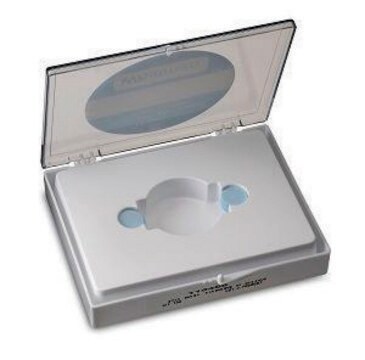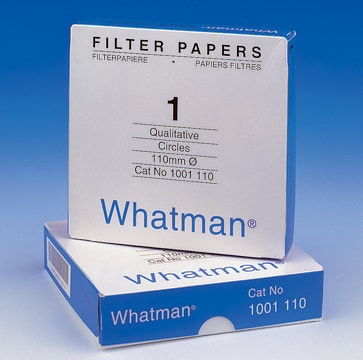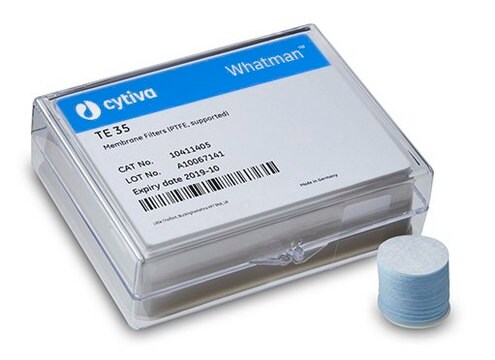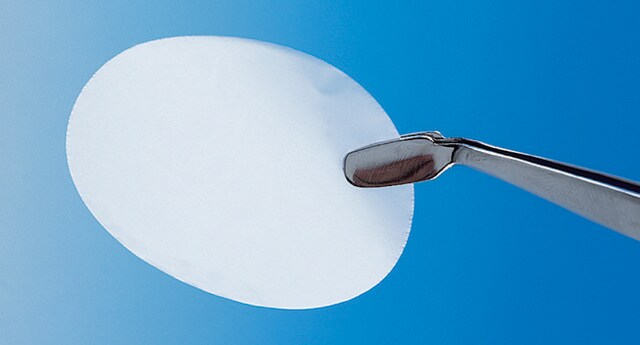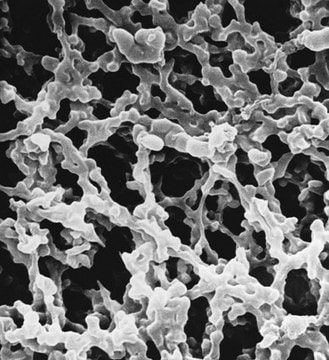WHA10417712
Whatman® polycarbonate Cyclopore® filter discs 0.4 μm pore size
translucent, hydrophobic, track-etched, 100 ea, 47 mm diam
Sign Into View Organizational & Contract Pricing
All Photos(2)
About This Item
UNSPSC Code:
41104900
NACRES:
NB.24
Recommended Products
product name
Whatman® Cyclopore® polycarbonate and polyester membranes, Cyclopore PC Circles, pore size 0.4 μm, diam. (47 mm), pack of 100 ea
sterility
non-sterile
packaging
pack of 100 ea
manufacturer/tradename
Whatman 10417712
diam.
(47 mm)
pore size
0.4 μm pore size
Looking for similar products? Visit Product Comparison Guide
General description
Whatman® Cyclopore Polycarbonate and Polyester Membranes
Whatman Cyclopore membranes are true pore size microporous membranes featuring sharp cut-off and reproducible microfiltration performance characteristics of track etched membranes. The smooth flat membrane ensures particles are retained on the surface so that they are easily visible under a microscope.
Cyclopore membranes are manufactured using proprietary Whatman technology to produce a precision membrane filter with a closely controlled pore size distribution.
Membranes are produced from a pure polymeric film and give exceptional chemical cleanliness. They are free of contaminants, have low tare weight, minimum water adsorption, and very low levels of nonspecific protein binding.
The polycarbonate (PC) membranes are hydrophilic and are available in a choice of diameters and pore sizes. The polyester (PE) membranes are resistant to most organic solvents, amides, and halogenated hydrocarbons. This broad chemical compatibility makes them suitable for the detection of particles in many corrosive fluids.
Whatman Cyclopore membranes are true pore size microporous membranes featuring sharp cut-off and reproducible microfiltration performance characteristics of track etched membranes. The smooth flat membrane ensures particles are retained on the surface so that they are easily visible under a microscope.
Cyclopore membranes are manufactured using proprietary Whatman technology to produce a precision membrane filter with a closely controlled pore size distribution.
Membranes are produced from a pure polymeric film and give exceptional chemical cleanliness. They are free of contaminants, have low tare weight, minimum water adsorption, and very low levels of nonspecific protein binding.
The polycarbonate (PC) membranes are hydrophilic and are available in a choice of diameters and pore sizes. The polyester (PE) membranes are resistant to most organic solvents, amides, and halogenated hydrocarbons. This broad chemical compatibility makes them suitable for the detection of particles in many corrosive fluids.
Application
Typical applications:
- Air monitoring - Trace elements (chemicals, radioactivity) and particulate analysis (dust, pollens, and airborne particles)
- Analytical methods - Gravimetric analysis, densitometry, emission spectroscopy, x-ray fluorescence, and infrared analysis
- Water analysis - Absorbable organic halides (AOX), direct count of microorganisms, marine biology and dissolved phosphates, nitrates, and ammonia analysis
- Blood filtration and cell analysis - RBC deformability, leukocyte removal, RBC filtration and plasmapheresis, chemotaxis, cytology, and cell culture
- General filtration - Particulate and bacteria removal, cross flow filtration, HPLC sample preparation, and solution filtration
- Microscopy - Electron microscopy, epifluorescence microscopy, and direct optical microscopy
- Microorganism analysis - Direct total microbial count, harvesting, concentration, fractionation, yeast, molds, Giardia, Legionella, coliform, and canine microfilaria
- Nucleic acid studies - Alkaline elution and DNA fragment fractionation
- Oceanographic studies - provide a new tool for studying planktonic organisms. These ultra thin transparent membranes are strong yet flexible, allowing for planktonic samples to be filtered and the membranes to be mounted directly onto microscope slides. (Ref: Hewes et al. 1998; Graham and Mitchell 1999; Graham 1999.)
- Biosensors - as a barrier offering controlled diffusion for biological reagents and electrochemical detectors
- Diagnostic assays - for flow control, sample preparation, blood separation, and capture of latex microparticles
- Cell biology - for cell culture, chemotaxis, and cytological analyses, e.g., direct staining, isotopic and fluorescence based assays
- Transdermal drug delivery - as an inert matrix for retention of therapeutics
Features and Benefits
Features and Benefits:
- Low affinity for stains providing higher optical contrast and making visibility under a microscope easy
- True surface capture provides easy examination of samples and short analysis times
- Totally transparent membranes available
- Negligible absorption and adsorption of filtrate; nonhygroscopic
- Low tare weights
- No particle shedding provides ultra clean filtrate
- Biologically inert
Legal Information
Cyclopore is a registered trademark of Whatman International Ltd.
Whatman is a registered trademark of Cytiva
Choose from one of the most recent versions:
Certificates of Analysis (COA)
Lot/Batch Number
Sorry, we don't have COAs for this product available online at this time.
If you need assistance, please contact Customer Support.
Already Own This Product?
Find documentation for the products that you have recently purchased in the Document Library.
Our team of scientists has experience in all areas of research including Life Science, Material Science, Chemical Synthesis, Chromatography, Analytical and many others.
Contact Technical Service
